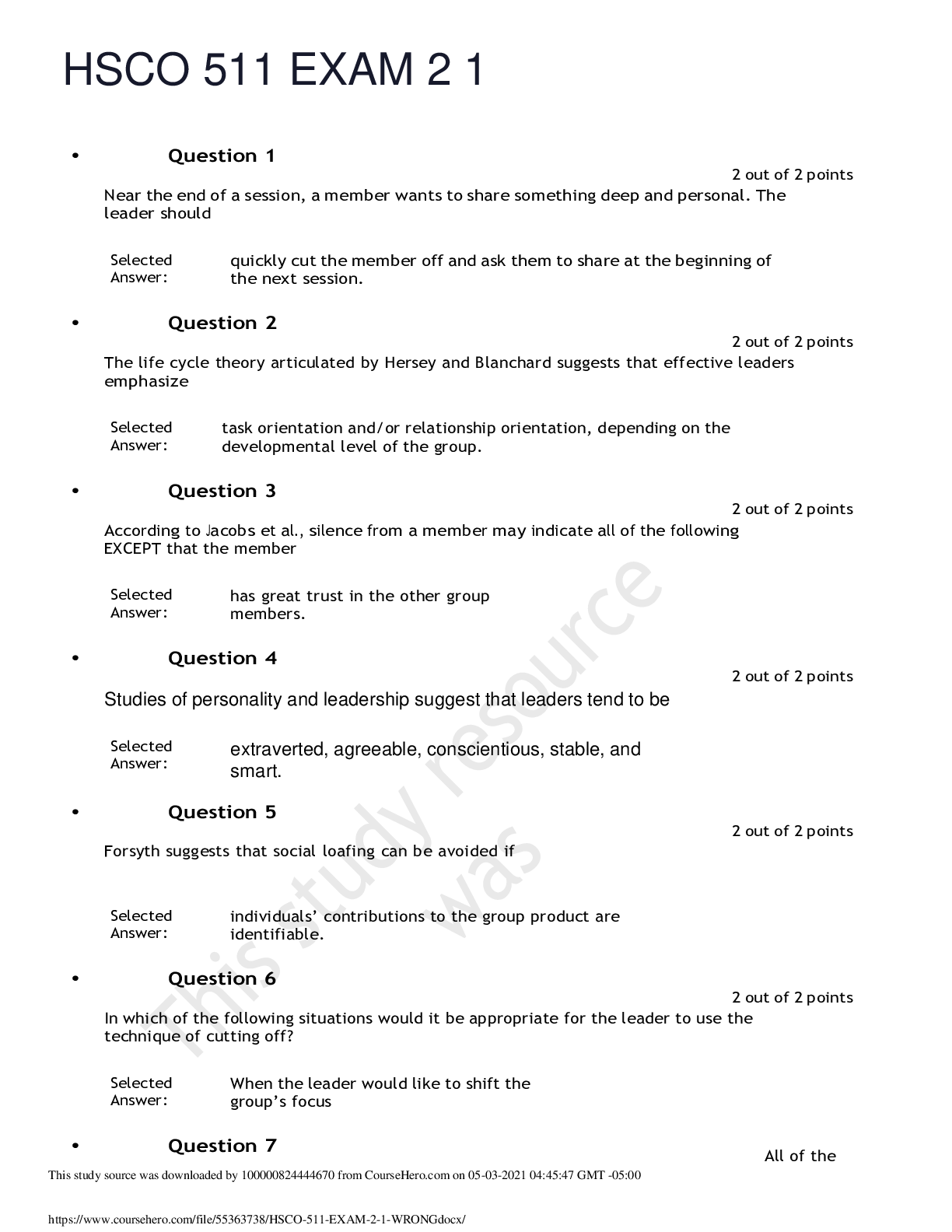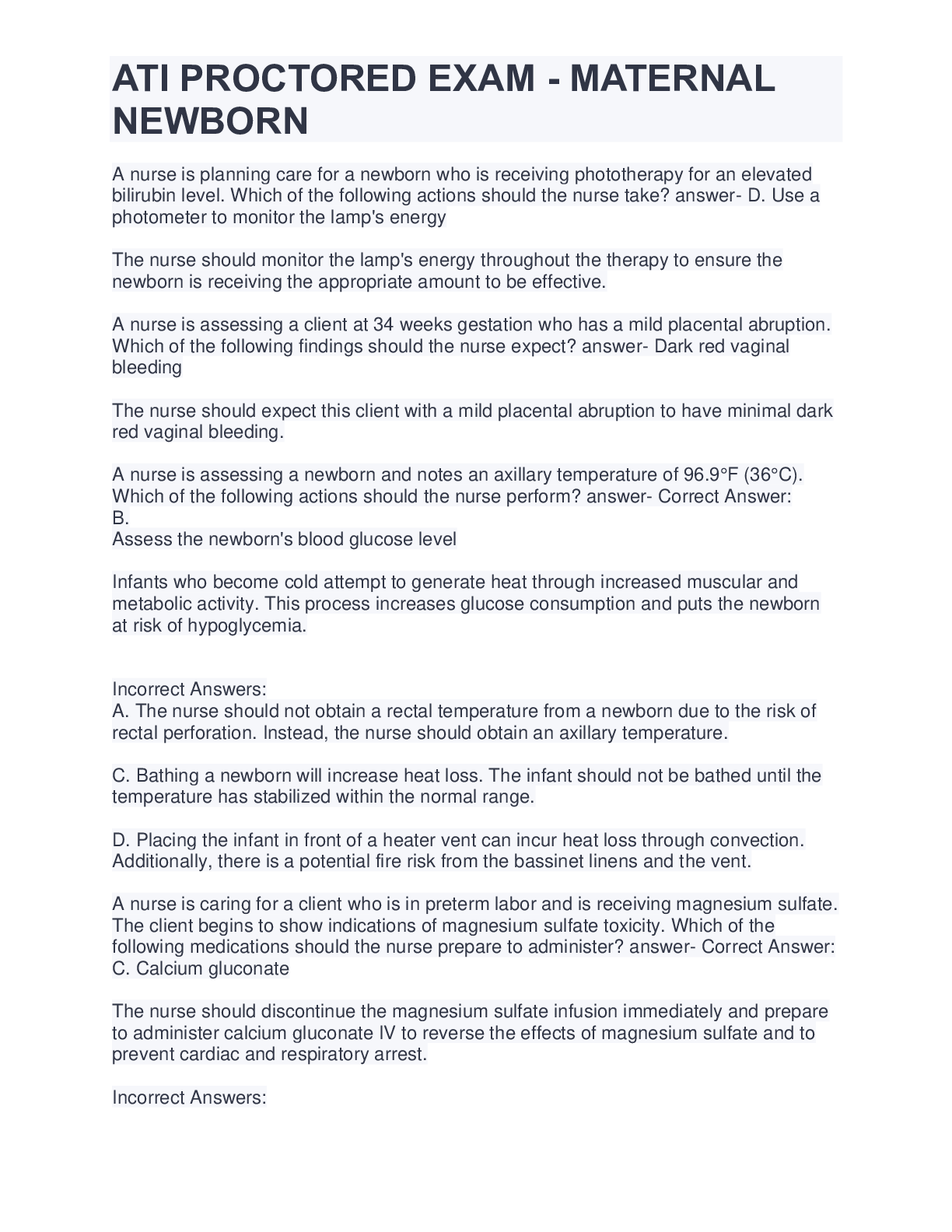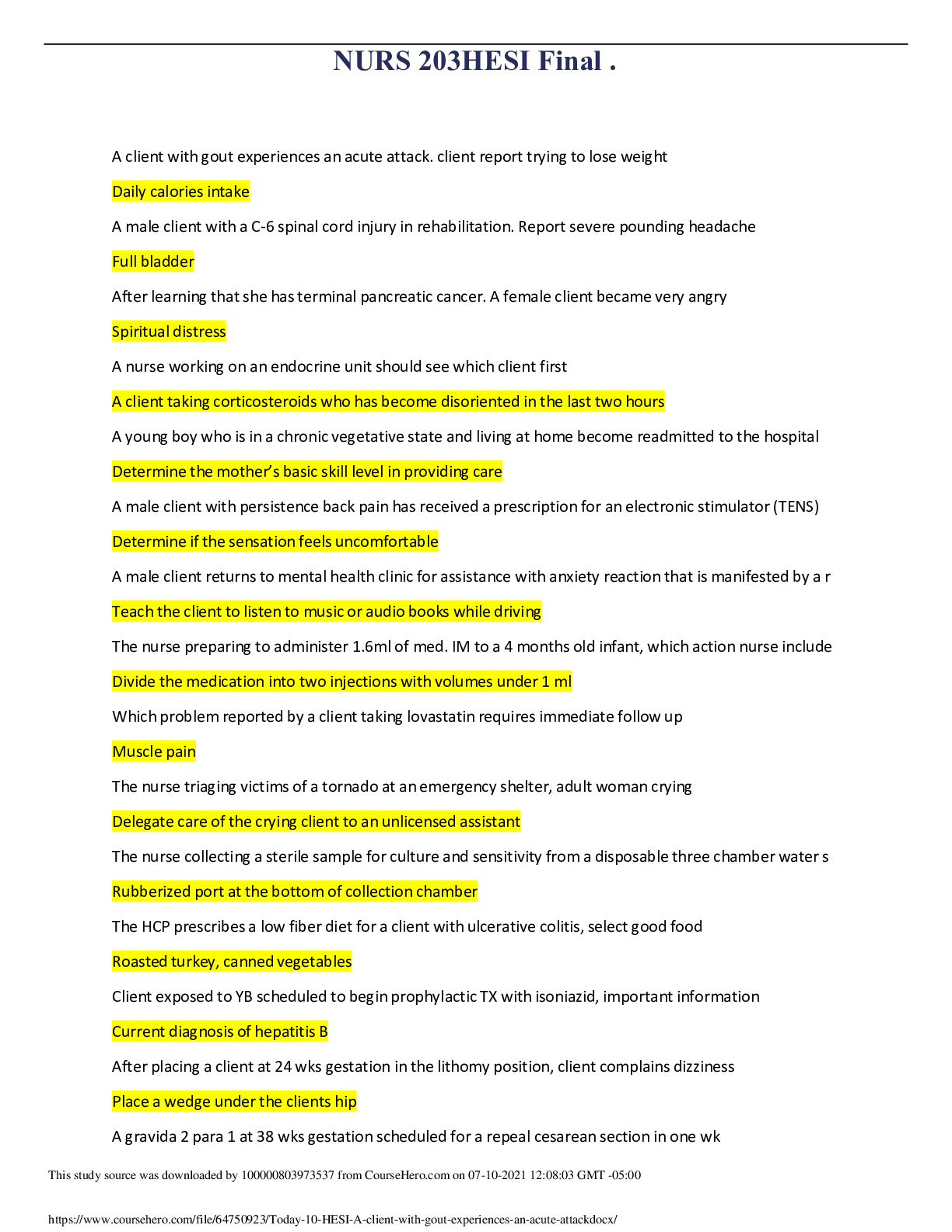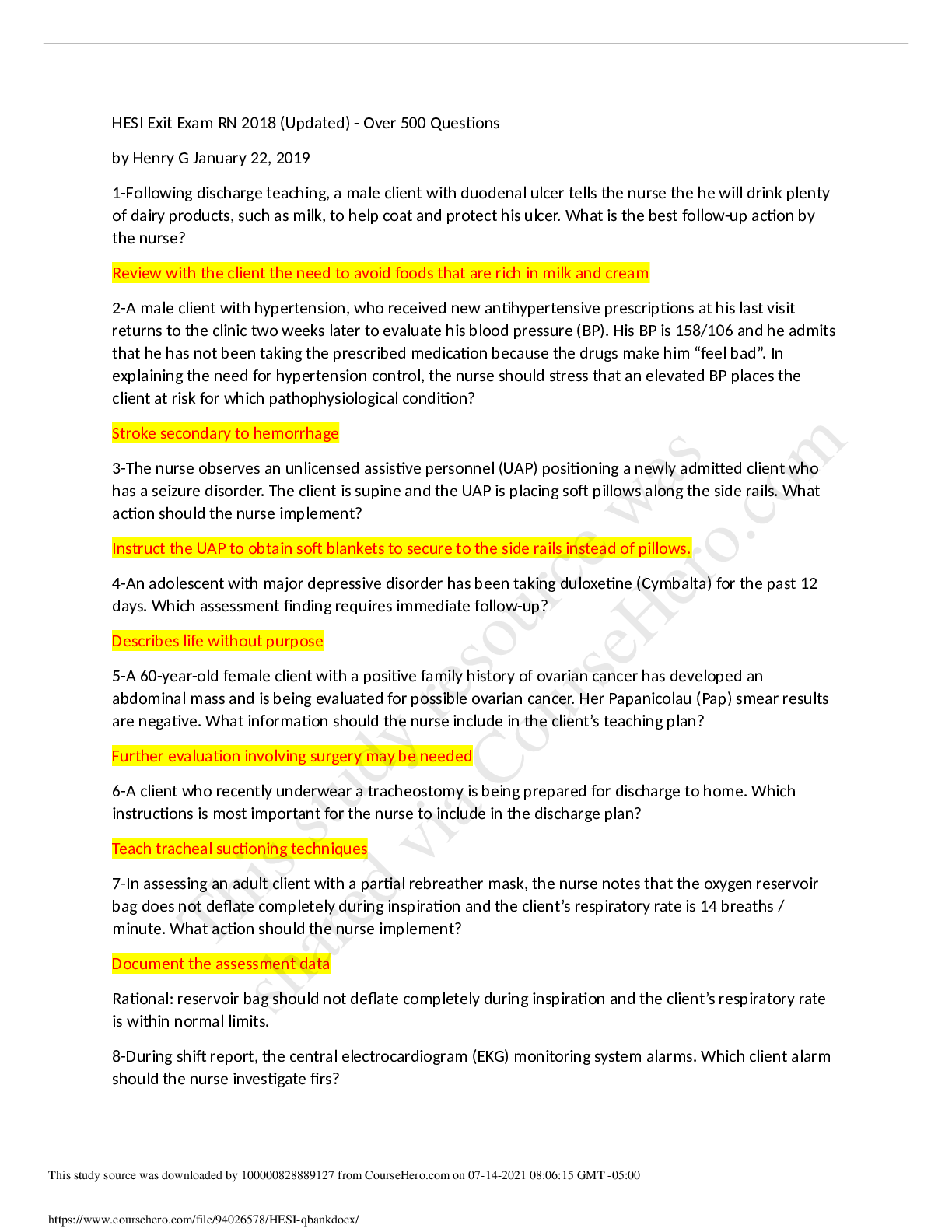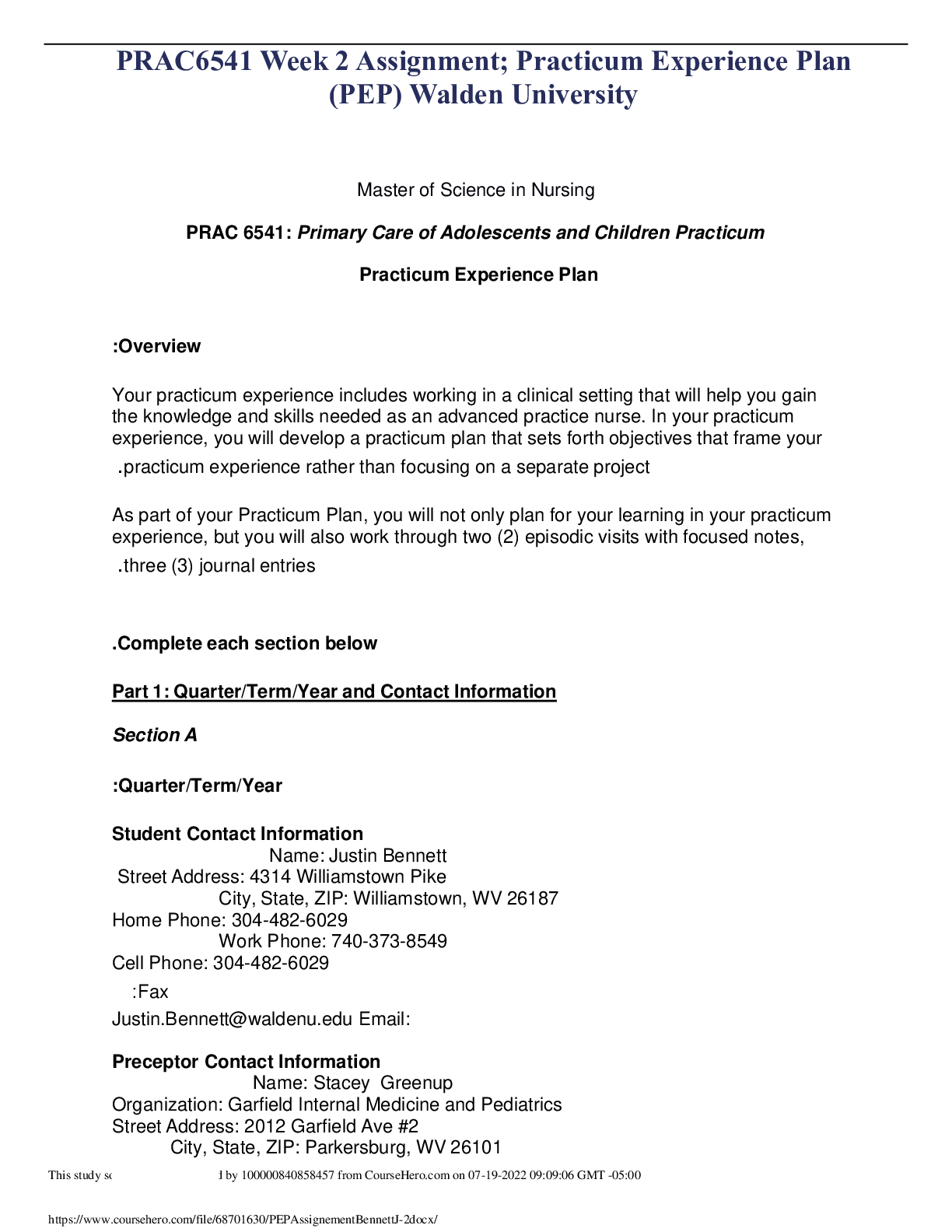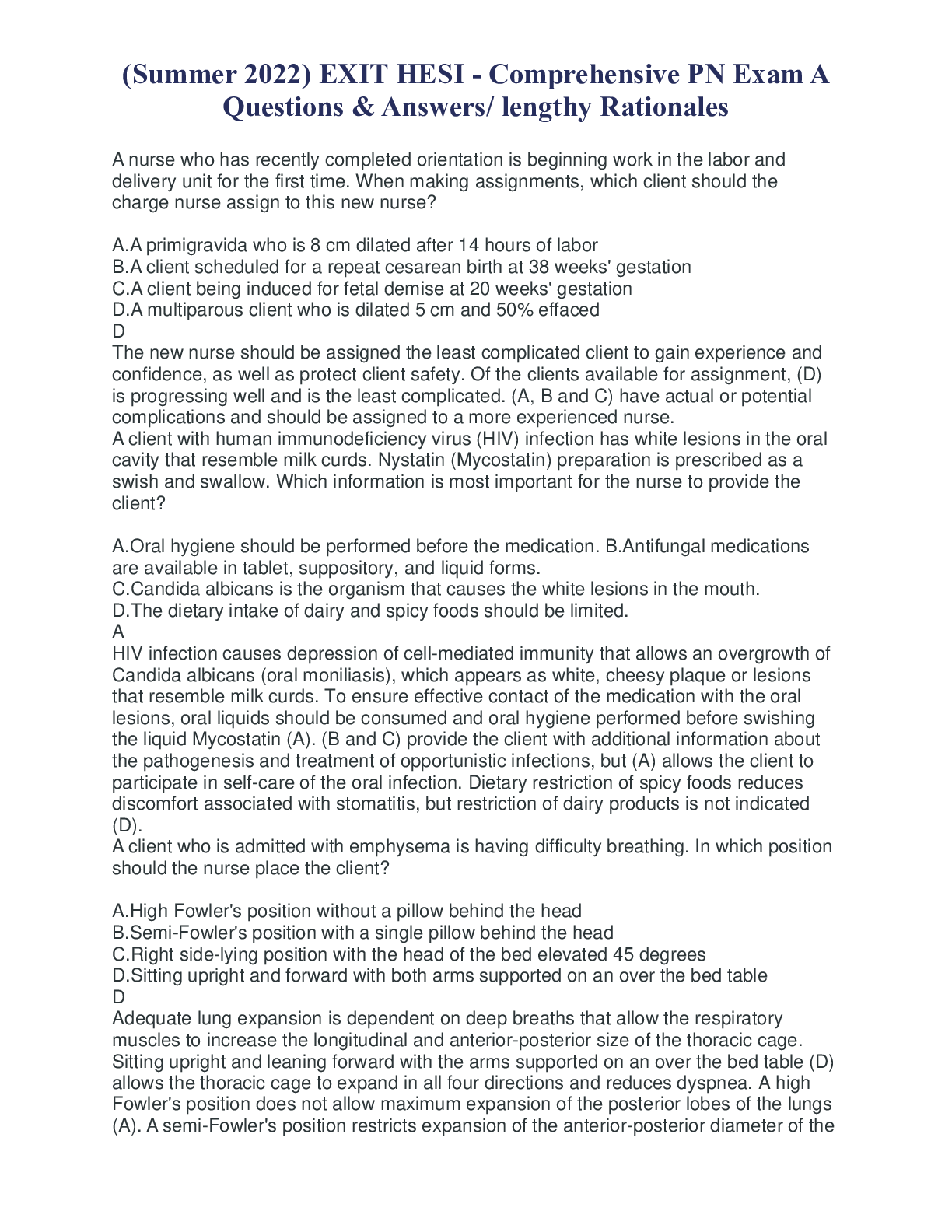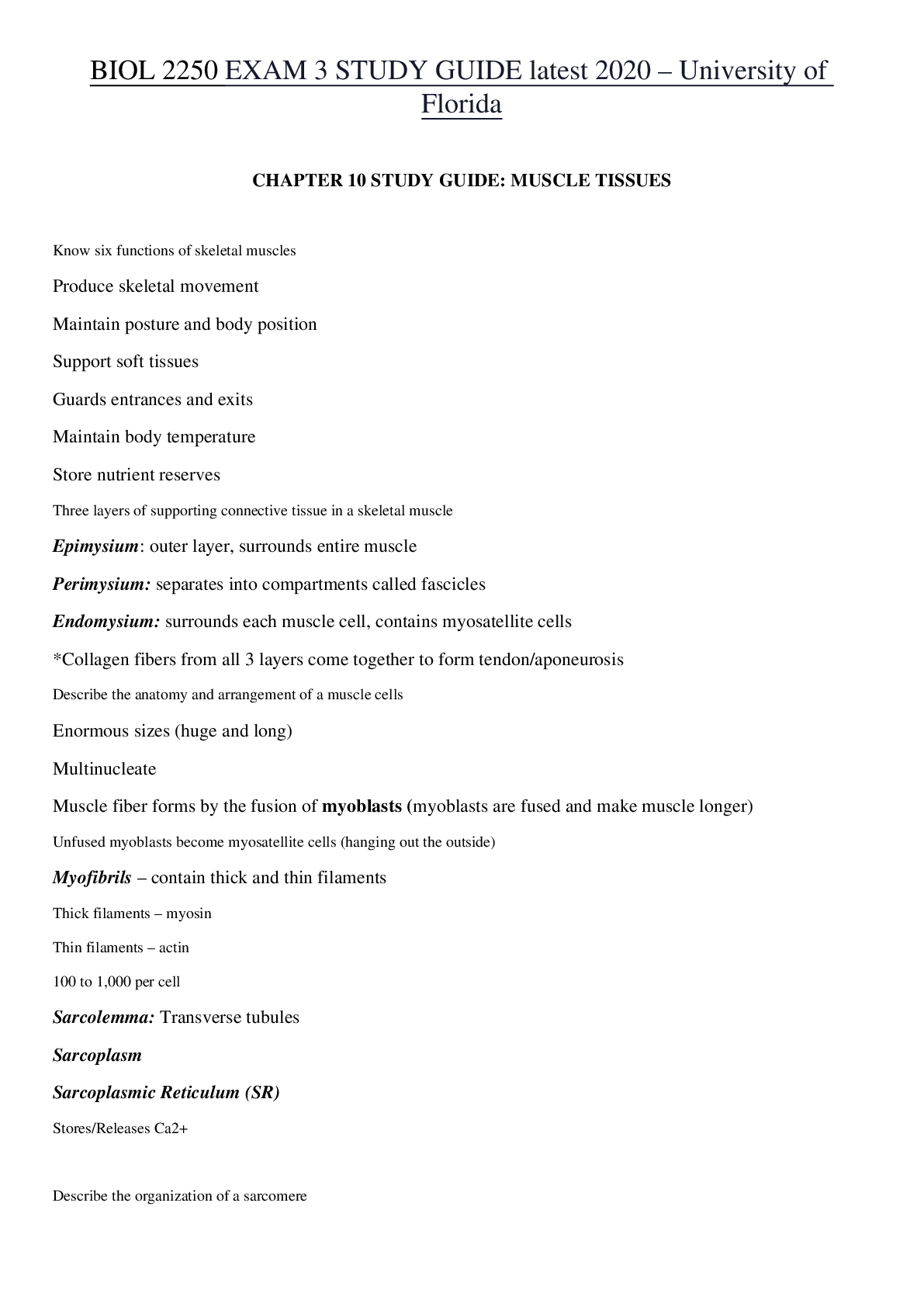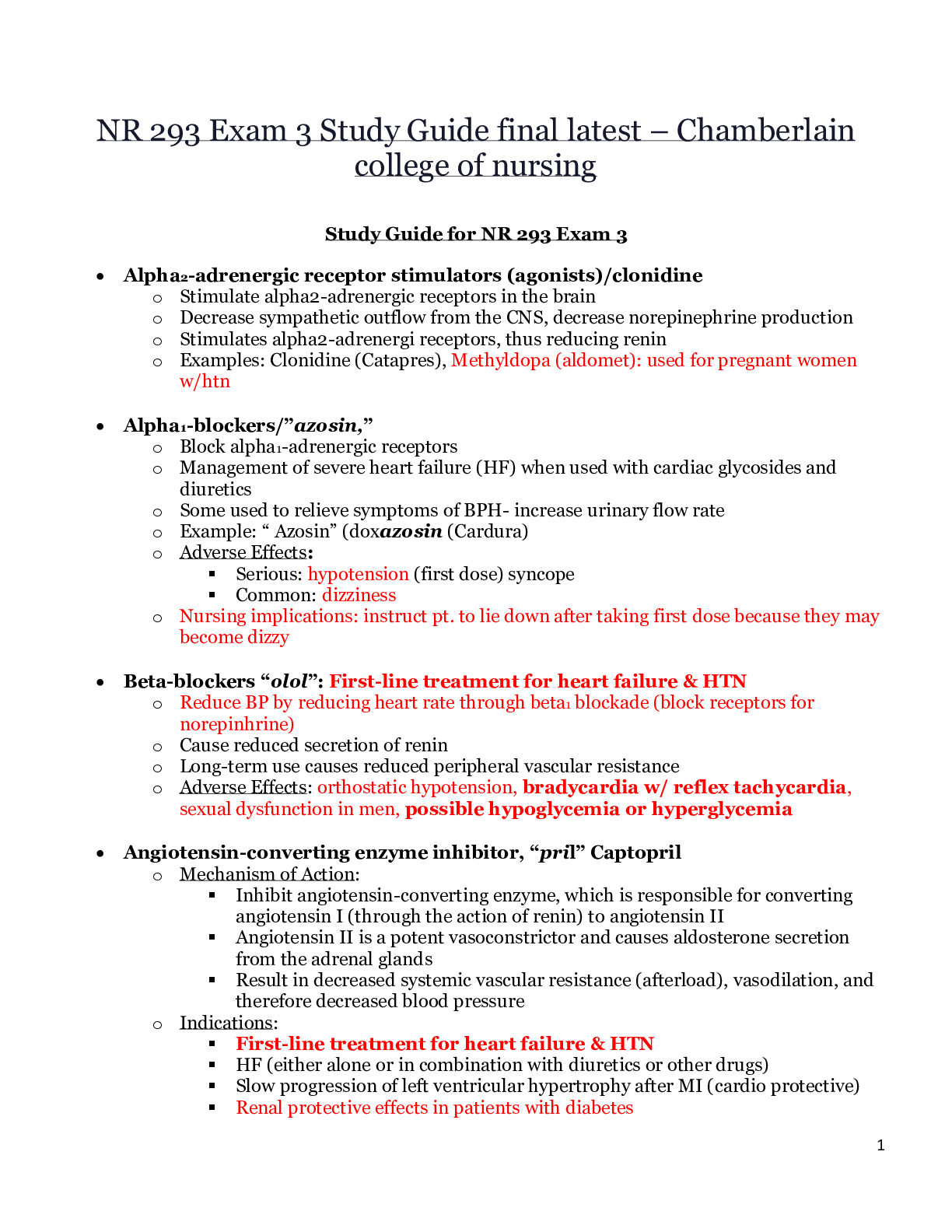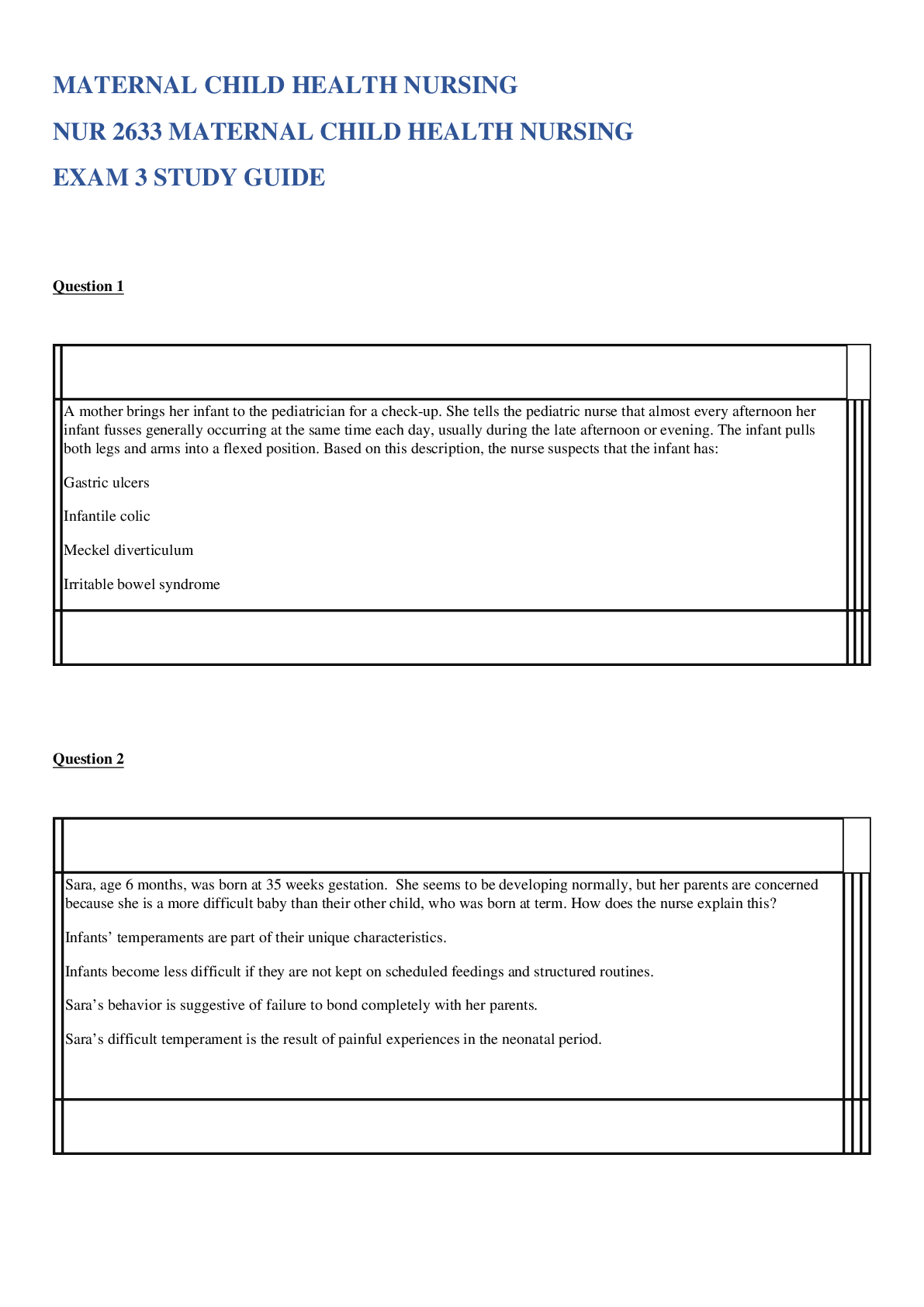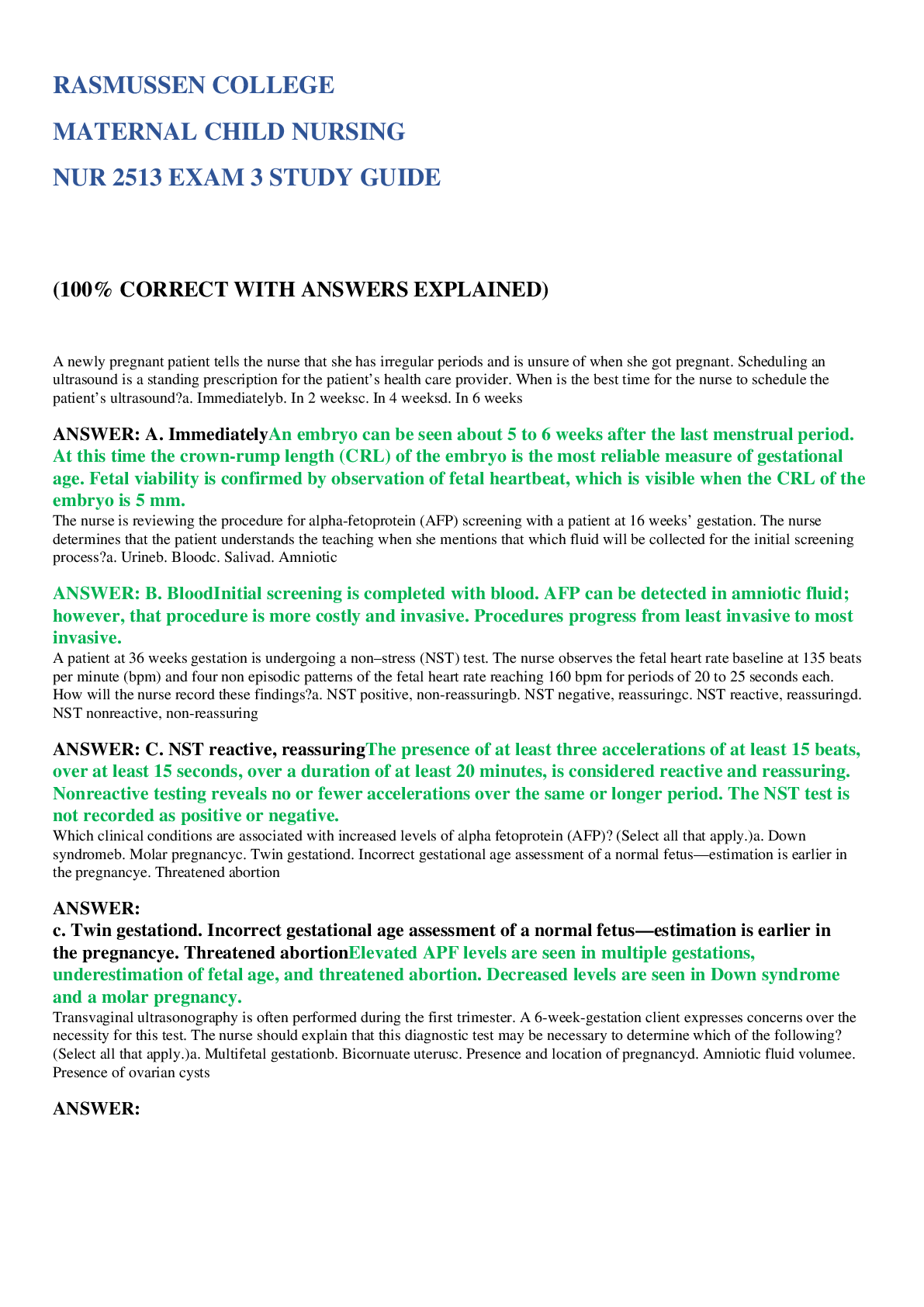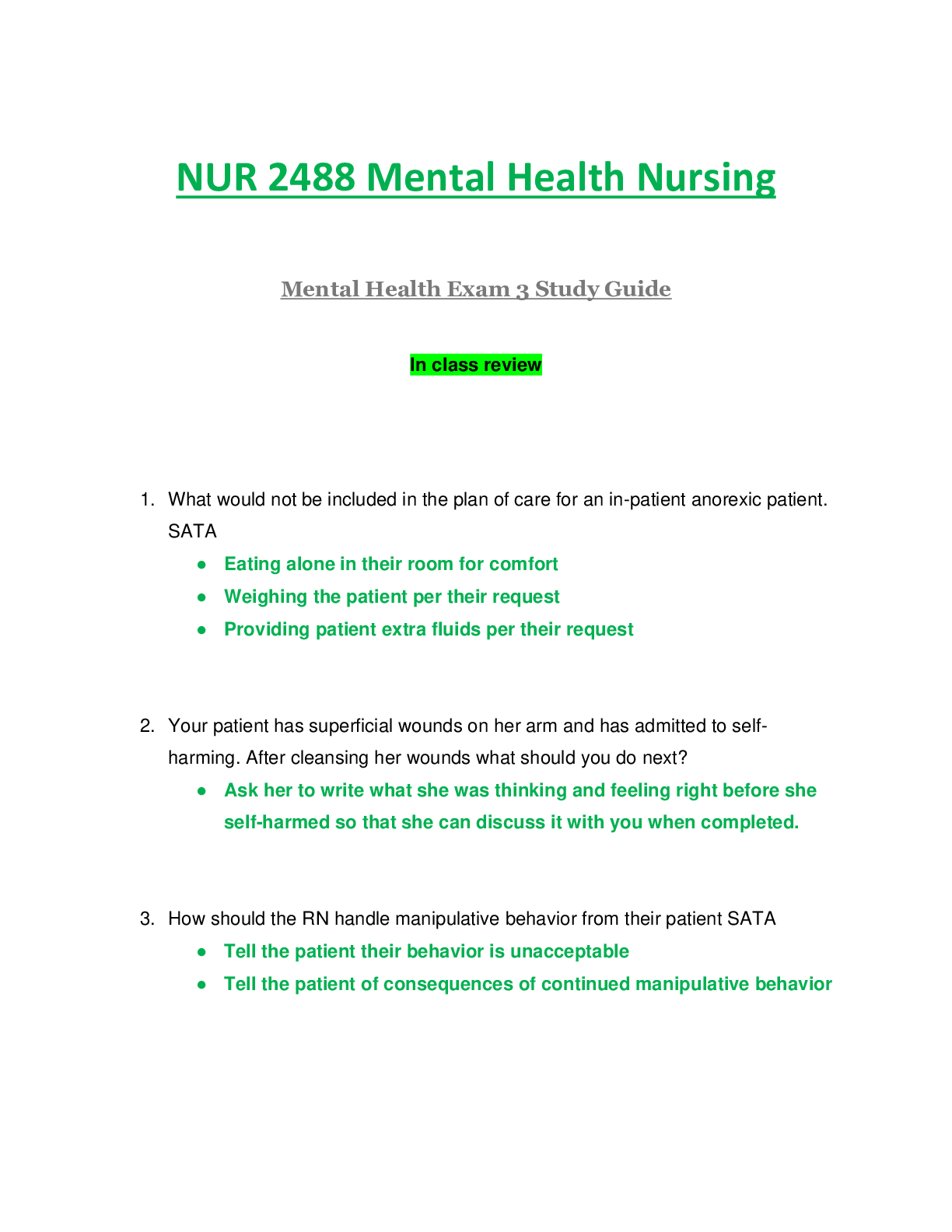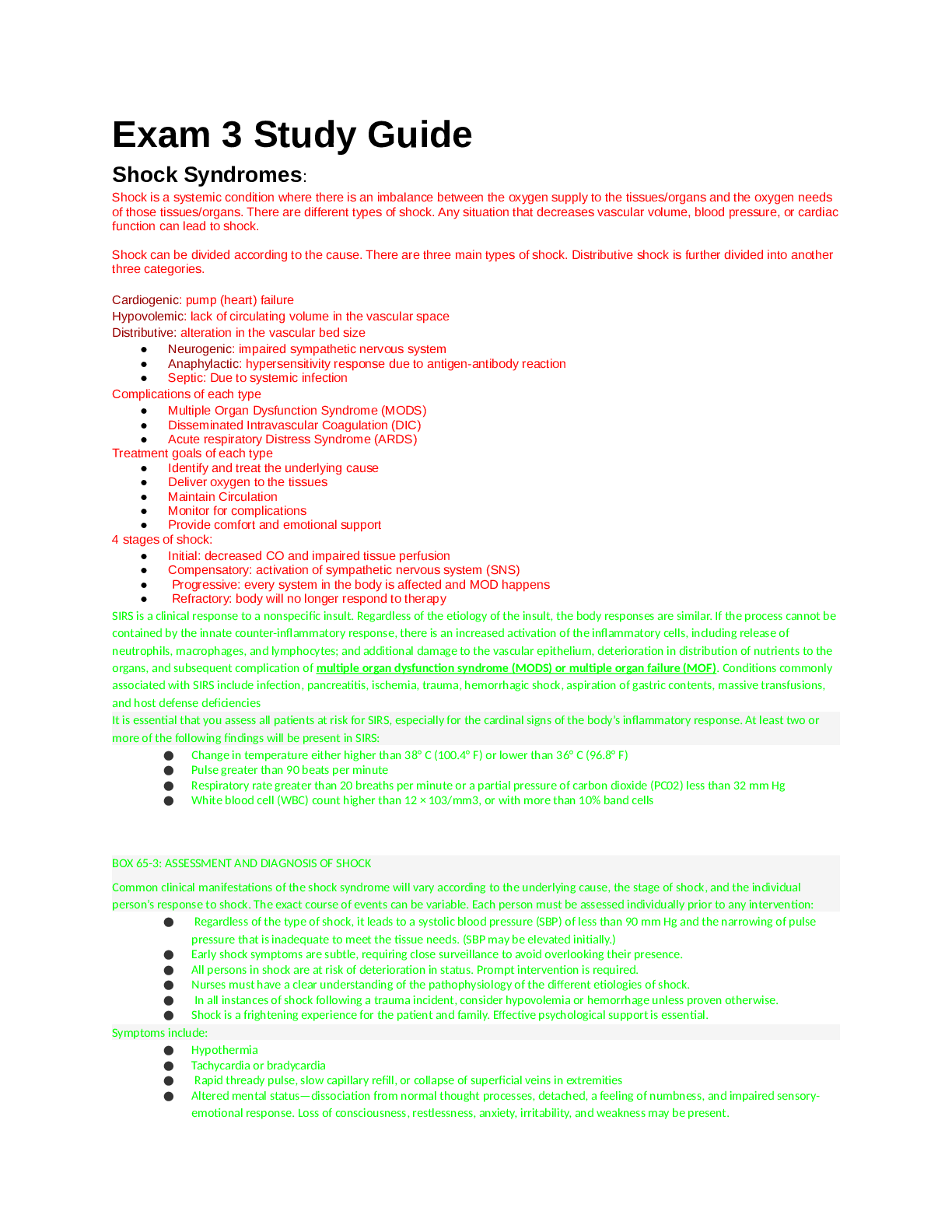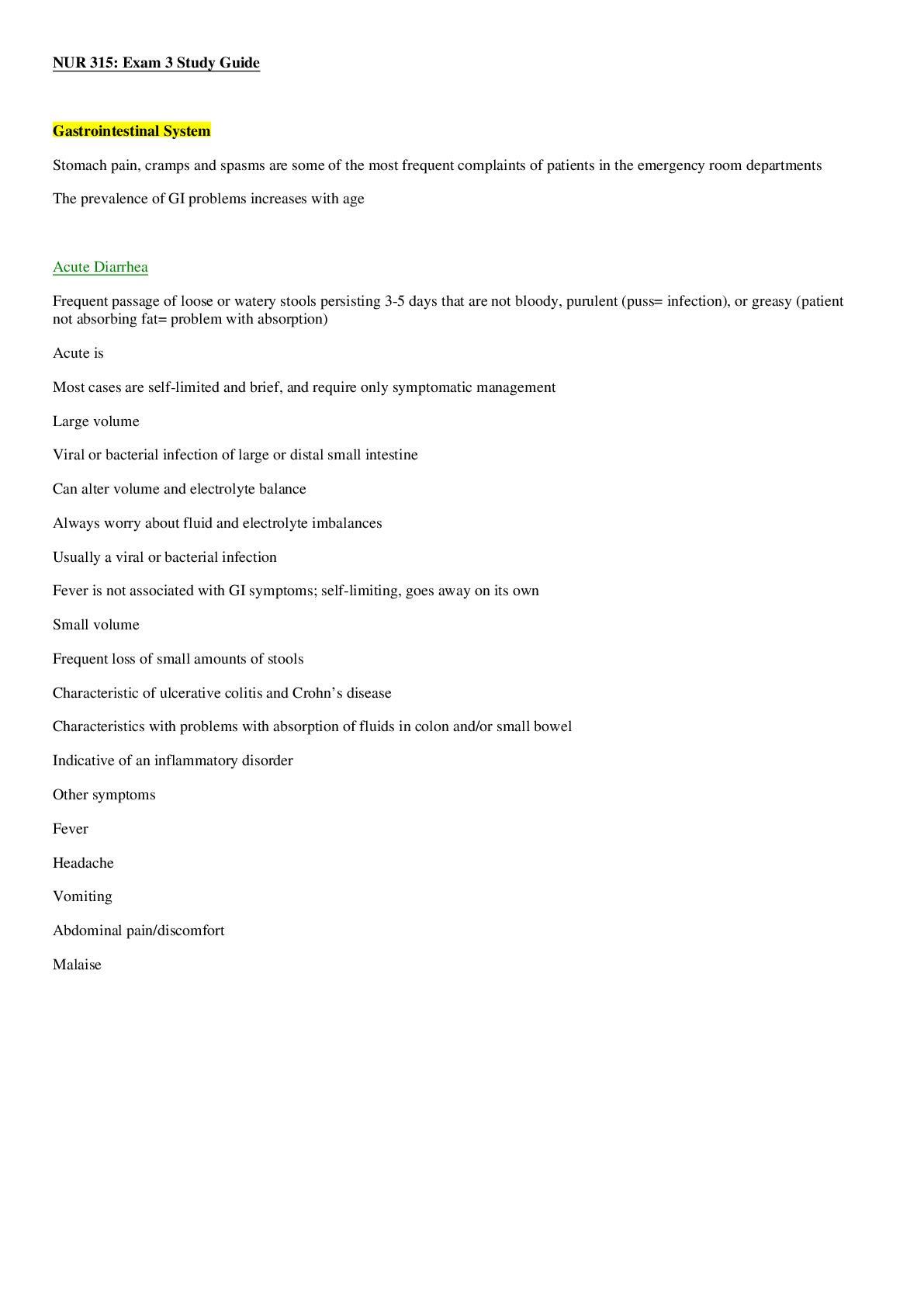NR 228 Exam 3 Study Guide,GRADED A.
Document Content and Description Below
Chapter 14: • Hepatitis-Causes and Diet: o Hepatitis A: fecal / oral (poor handwashing) ▪ vaccine ▪ asymptomatic ▪ adequate nutrition needed / NO alcohol o Hepatitis B: blood, sexual con... tact, vaginally during delivery ▪ vaccine ▪ asymptomatic ▪ adequate nutrition needed / NO alcohol o Hepatitis C: blood, saliva, tears, semen ▪ no dietary recommendations ▪ baby boomers get this the most o Hepatitis D: only occurs if you already have Hep. B ▪ no dietary recommendations ▪ risk factor: IV drug use o Hepatitis E: self-limiting, enterically transmitted ▪ risk factors: travel to tropical areas ▪ avoid drinking water and avoid uncooked fruits and veggies ▪ no vaccine • Fatty Liver at Risk and Diet: o avoid over nutrition - high fat - high fructose - weight loss w/out skipping meals o mist common cause: alcohol - obesity - some medications - parenteral nutrition o liver disease ---> impairs protein synthesis ---> most affected is the immune system • Liver Failure/Cirrhosis/Esophageal Varices/Ascites: o Liver Failure: o Cirrhosis: protein and energy malnutrition common, soft, low-fiber, sodium and fluid restriction ▪ chronic disease o Esophageal Varices: soft diet o Ascites: sodium retention -- cannot use actual weight because of the fluid, need to find another way to weigh these pts • Gall Bladder Risk and Diet: o occlusion can lead to ---> liver problems / failure or pancreatitis o risk factors ---> rapid weight loss through low calorie diets, very low fat diet, skipping breakfast o avoid fatty foods o IV fluids Chapter 16: • When/How to Resume Post-Op Diet: o assess swallowing ability before transition o slowly advance diet o increase oral intake while decreasing tube feedings o proper assessment of GI tract required before weaning from parenteral nutrition o presence of bowel sounds • Calorie Counts: o done for the malnourished pt. o best way to evaluate poor appetite • Burn Injury Diet: o enteral nutrition needs to start w/in the first 24 hrs. of transmission • Diabetes: o diagnosed via blood glucose level > 126 fasting (must be collected two times to determine) o A1C normal is 4-6% and over 6.5% indicates type II DM o Type I ---> insulin deficient - have to be on insulin for the rest of their life, early s/s are the 3 P’s o Type II ---> insulin resistance / intolerance - diet, oral meds, insulin o tx ---> diet ---> carb counting o hypoglycemia ---> rule of 15 (pts skin, hot and dry the sugar is high) • Supplements for Wounds: o vitamin C o zinc Chapter 17: • Triglycerides: o At risk: diabetic pts - overweight pts - alcohol abuse pts - sedentary lifestyle - smoking - high carb. intake - genetic factors - meds. o most common fat found in the bloodstream • Cholesterol: o high cholesterol ---> over 200 o sterols = cholesterol o bile, vitamin D, sex hormones, cells in the brain and nerve tissue o food sources: meats - fish - dairy (plants don’t contain cholesterol) o LDL = amt. of cholesterol brought to the cells that has the potential to be dropped off along the way to clog vessels (puts cholesterol on the walls) ▪ should be evaluated every 6 weeks after changing diet • Heart Healthy Foods: o DASH diet ---> low sodium ▪ increasing fruits and veggies ▪ decreasing dairy - red meat - soup - sauce - spices - sauerkraut - snacks - sodium processed meats o Mediterranean diet ---> low cholesterol (consume a lot of olive oil) ▪ fruits, veggies, grains and only source of protein comes from fish ▪ 40% of calories from fat o Basic diet ---> low sodium and low cholesterol - fluid restriction • HTN Treatment: o weight loss o reduce sodium o usually results are seen w/in 2 weeks o increase fruit and veggie intake o decrease dairy intake o decrease red meat o decreasing soup - sauce - spices - sauerkraut - snacks - sodium processed meats • COPD Diet: o feeding has to balance CO2 production ---> more CO2 is made from carbs ▪ 50% of non-protein calories needs to be from fats and carbs ▪ protein stays the same ▪ carbs and fats are going to be 50/50 ▪ need to decrease calories consumed from carbs in order to decrease the amt. of carbon dioxide they have in their system ▪ fat and carbs are supposed to be 50% of non-protein • Heart Failure Diet: o decrease sodium (1500 mg) and decrease fluid (1-2 L per day) o want to increase kcals but not increase the amt. of food being consumed o low sodium - low cholesterol - fluid restriction • CF: o need pancreatic enzyme replacement o malabsorption for almost all nutrients o exceed DRIs for all nutrients by 1.2-2 times kcals and ALL nutrients o need multivitamin Chapter 18: • Nephrotic Syndrome: o increased protein in the urine (increase urinary excreting protein - proteinuria) o nutrition ---> control HTN - minimize edema - muscle catabolism - high carb diet - protein restriction - Na+ restriction • Most Common Cause of Acute Renal Failure: o nephrotoxicity (Ibuprofen) • Foods High in Potassium: o kale - bananas - oranges - legumes - tomatoes - yogurt - avocados • Renal Failure: o supplements ---> iron - nephrocaps - vitamin D o avoid phosphorus ---> competes w/ calcium for receptors and increases risk for bone loss • Types of Diets: o Clear Liquid: 24 hrs. only o Full Liquid: complete nutrition ▪ same as clear diet but w/ milk products and all juices o Level 1 Dysphagia Pureed Diet: completely blended, pudding consistency o Level 2 Dysphagia Mechanically Altered: food is moistened, meat is ground up, served w/ gravy o Level 3 Dysphagia Advanced: hard, sticky, crunchy foods are omitted o Level 4 Dysphagia: return to normal diet o Mechanically Altered Diet: chopped, ground, mashed, pureed o Soft Diet: transition from liquid to regular diet Chapter 20: • Diets for Radiation and Mucositis: o decrease risk of surgical complications o able to meet energy and protein requirements o neutropenic diet ---> no raw or undercooked meats - pasteurized milk, juice, eggs - wall washed fruits and veggies o increase kcals o mechanically soft diet • Cachexia: complex syndrome wasting of lean body mass / weight loss o affects 50% of cancer pts. o take Megace ---> appetite stimulant o NSAIDs ---> omega-3 fatty acids Miscellaneous Questions: • Dysphagia: o s/s: coughing - drooling - eating slowly o stroke - esophageal varices - Parkinson’s o sit the pt. upright and give them a lot of time to eat o foods that are not consistent in structure are the most difficult to eat • Lactose Intolerance: o lactose enzyme to help tolerate dairy products • Vitamin K Deficiency: o blood coagulation o interacts w/ Warfarin (Coumadin) o foods ---> leafy greens (kale - broccoli) • B12: pernicious anemia o intrinsic factor is needed to increase absorption of B12 • Proteins Complete / Incomplete: o Complete: has all 9 essential amino acids (breast milk - soy - eggs) o Incomplete: cannot live off of o Sources: legumes - soy beans - animal products • Extra Info: o Primary Deficiency: not enough being consumed o Secondary Deficiency: eating enough but the body is responding properly o vitamin D is the only vitamin created in the body o needs 2 cups of fruits and 2 ½ cups of veggies per day o need B6 to absorb amino acids [Show More]
Last updated: 1 year ago
Preview 1 out of 5 pages

Buy this document to get the full access instantly
Instant Download Access after purchase
Add to cartInstant download
We Accept:

Reviews( 0 )
$26.00
Document information
Connected school, study & course
About the document
Uploaded On
Apr 29, 2021
Number of pages
5
Written in
Additional information
This document has been written for:
Uploaded
Apr 29, 2021
Downloads
0
Views
105

